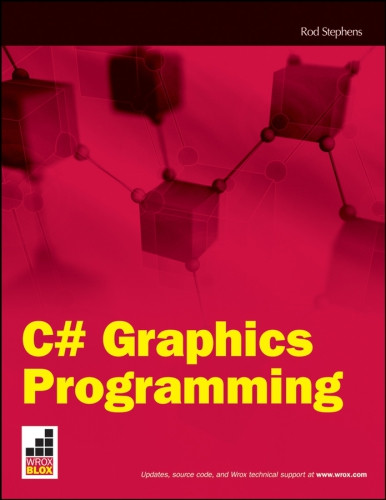Product desciption
C Graphics Programming 1st Edition Stephens Rod by Stephens, Rod 9780470343494, 0470343494 instant download after payment.
This Wrox Blox teaches you how to add graphics to C# 2008 applications, explaining fundamental graphics techniques such as: drawing shapes with different colors and line styles; filling areas with colors, gradients, and patterns; drawing text that is properly aligned, sized, and clipped exactly where you want it; manipulating images and saving results in bitmap, JPEG, and other types of files. Also covered are instructions for how to greatly increase your graphics capabilities using transformations. Transformations allow you to move, stretch, or rotate graphics. They also let you work in coordinate systems that make sense for your application. You will also learn how to use all of these techniques in printouts. The author describes the sequence of events that produce a printout and shows how to generate and preview printouts. The final sections describe two powerful new graphic tools that were introduced with .NET Framework 3.0: WPF graphics and FlowDocuments. WPF applications can use XAML graphic commands to declaratively draw and fill the same kinds of shapes that a program can draw by using graphics objects. Finally, a discussion on the FlowDocument object shows you how to define items that should be flowed across multiple pages as space permits. This lets you display text, graphics, controls, and other items that automatically flow across page breaks. FlowDocument viewers make displaying these documents easy for you, and simplifies the user's reading of the documents. This Wrox Blox also contains 35 example programs written in C# 2008, although most of the code works in previous versions of C# as well. The most notable exceptions are WPF graphics and FlowDocuments, both of which require WPF provided in .NET Framework 3.0 and later.
Abstract: This Wrox Blox teaches you how to add graphics to C# 2008 applications, explaining fundamental graphics techniques such as: drawing shapes with different colors and line styles; filling areas with colors, gradients, and patterns; drawing text that is properly aligned, sized, and clipped exactly where you want it; manipulating images and saving results in bitmap, JPEG, and other types of files. Also covered are instructions for how to greatly increase your graphics capabilities using transformations. Transformations allow you to move, stretch, or rotate graphics. They also let you work in coordinate systems that make sense for your application. You will also learn how to use all of these techniques in printouts. The author describes the sequence of events that produce a printout and shows how to generate and preview printouts. The final sections describe two powerful new graphic tools that were introduced with .NET Framework 3.0: WPF graphics and FlowDocuments. WPF applications can use XAML graphic commands to declaratively draw and fill the same kinds of shapes that a program can draw by using graphics objects. Finally, a discussion on the FlowDocument object shows you how to define items that should be flowed across multiple pages as space permits. This lets you display text, graphics, controls, and other items that automatically flow across page breaks. FlowDocument viewers make displaying these documents easy for you, and simplifies the user's reading of the documents. This Wrox Blox also contains 35 example programs written in C# 2008, although most of the code works in previous versions of C# as well. The most notable exceptions are WPF graphics and FlowDocuments, both of which require WPF provided in .NET Framework 3.0 and later


